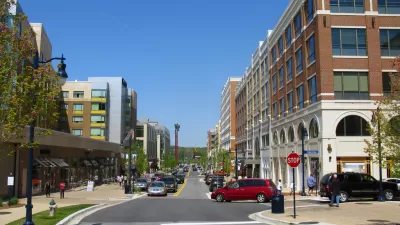When communities feel like street traffic is unsafe, they usually demand stop signs or traffic lights to be installed. But studies show that those devices may actually make streets less safe.
Noah Kazis talks with Prof. Reid Ewing of the University of Utah, author of the book Traffic Calming: State of the Practice. "
"They're good for traffic control," said Ewing of stop signs and traffic lights. "They're not so good for traffic calming." In other words, they help make traffic flow in a more orderly fashion, but not necessarily in a safer one.
"We kind of panned stop signs as a traffic calming measure," continued Ewing. "They don't do a lot for speeding, because there's a tendency for drivers to make up for the lost time."
Much more about the effectiveness and politics of traffic calming vs. stop signs at Streetsblog.
Thanks to Noah Kazis
FULL STORY: To Get Safer Streets, Traffic Lights and Stop Signs Aren’t the Answer

Planetizen Federal Action Tracker
A weekly monitor of how Trump’s orders and actions are impacting planners and planning in America.

Maui's Vacation Rental Debate Turns Ugly
Verbal attacks, misinformation campaigns and fistfights plague a high-stakes debate to convert thousands of vacation rentals into long-term housing.

San Francisco Suspends Traffic Calming Amidst Record Deaths
Citing “a challenging fiscal landscape,” the city will cease the program on the heels of 42 traffic deaths, including 24 pedestrians.

Amtrak Rolls Out New Orleans to Alabama “Mardi Gras” Train
The new service will operate morning and evening departures between Mobile and New Orleans.

The Subversive Car-Free Guide to Trump's Great American Road Trip
Car-free ways to access Chicagoland’s best tourist attractions.

San Antonio and Austin are Fusing Into one Massive Megaregion
The region spanning the two central Texas cities is growing fast, posing challenges for local infrastructure and water supplies.
Urban Design for Planners 1: Software Tools
This six-course series explores essential urban design concepts using open source software and equips planners with the tools they need to participate fully in the urban design process.
Planning for Universal Design
Learn the tools for implementing Universal Design in planning regulations.
Heyer Gruel & Associates PA
JM Goldson LLC
Custer County Colorado
City of Camden Redevelopment Agency
City of Astoria
Transportation Research & Education Center (TREC) at Portland State University
Jefferson Parish Government
Camden Redevelopment Agency
City of Claremont




























